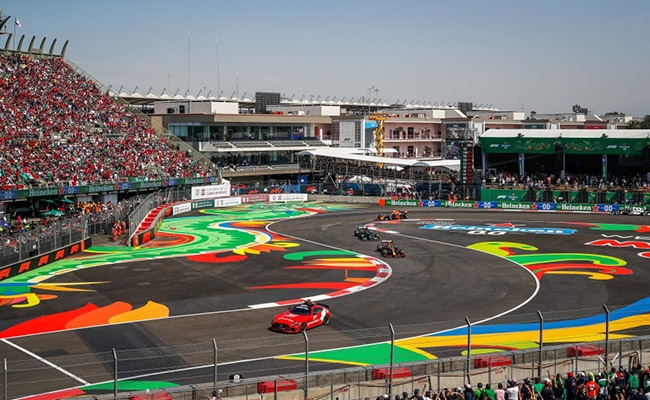On Sunday, Oct. 29, several hundred thousand fans will pack Autodromo Hermanos Rodriguez for the Mexico City Grand Prix, the 20th of 23 races on the 2023 Formula 1 World Championship.
Superstars Max Verstappen, Sergio Perez and Lewis Hamilton and others will compete over 71 laps of the 4.304-kilometre track in one of the most dangerous, exciting and popular sports in the world.
Here on campus that day, fans of F1, as it is commonly called, or those interested in learning more about the open-wheeled racing circuit whose worldwide audience rivals that of soccer, are invited to gather in O’Brien Center 117 at 3:30 p.m. to watch the race. In a blending of sports with academia, the event will also feature faculty presentations on not only the basics of F1, but the science and engineering behind the single-seat race cars that can reach optimal speeds of 220 mph.
“We want to share our passion for this sport and share that it is not just about engineering a great car, it is about the drivers as well and the endurance required during a race,” said Jennifer Currey, associate professor of biomedical engineering and one of the presenters at the event.
She will be joined by Nick Webb, associate professor of computer science. Before the race, Currey will discuss track, car, and barrier design in regards to the safety of the drivers, from a biomedical engineering standpoint.
Webb will offer a beginner's guide to F1 racing. He will also discuss the nationality of drivers and the cultural significance of the race in Mexico close to the Día de Muertos, or Day of the Dead celebration.
Both professors are longtime fans of the sport. Currey’s father loved F1 racing and passed along his passion to three of his four daughters.
“I have memories of watching races with him and I used to love the sounds of the cars,” said Currey. “When I was in middle school, my dad took me and one of my sisters up to Montreal for the Grand Prix. We went for a few years and it was so amazing to see a race live.”
Her perspective of the sport has changed since she became an engineer.
“The engineering of the car is a big focus for sure,” she said, “but I have grown more and more interested in understanding how the cars are engineered for the safety of the driver, how the tracks have been designed to slow cars safely in a crash, and how the drivers physically train to prepare themselves for races.”
Webb is also a veteran observer of the sport.
“I have been watching F1 for over 40 years,” Webb said. “I am a huge motor racing fan, and started watching F1 races on a Sunday with my parents. Although I've never driven anything that fast in real life, I regularly compete in simulated racing in all kinds of cars. As a data scientist, the level of real time data analysis from F1 machines is simply staggering.”
For those not familiar with F1, 20 drivers and 10 teams compete in a series of Grand Prix weekends across multiple continents from March to December. The event includes practice sessions Friday and Saturday, qualifying sessions to determine starting positions later Saturday, and the race itself Sunday.
Each team engineers its single-seat car to race around the track. Points are awarded based on how they finish.
The sport is wildly popular in Europe and in countries like China and Brazil, and has a strong following among Union’s international students.
In the United States, the sport is gaining in popularity, fueled in part by the success of “Formula 1: Drive to Survive,” a behind-the-scenes docuseries on Netflix about what happens on and off the track.
It was a conversation between Currey and President David Harris about the show that ignited the idea for a watch party. As it turns out, Harris' daughter, Olivia, is a fan of "Drive to Survive," which prompted the discussion between Currey and Harris about F1. From that, the seed of an event was planted.
Ebyan Abshir '24, presidential fellow, is the lead organizer of the event. The President’s Office and the departments of Electrical, Computer and Biomedical Engineering, and Computer Science, in collaboration with student groups SAE Aero, SAE Baja and Society of Women Engineers, are sponsors of the event.
“We envisioned that this would be exciting for our international students given that F1 is one of the most popular major sports in the world,” said Currey. “We also thought it would be a great opportunity to share some of the engineering around the sport.”
